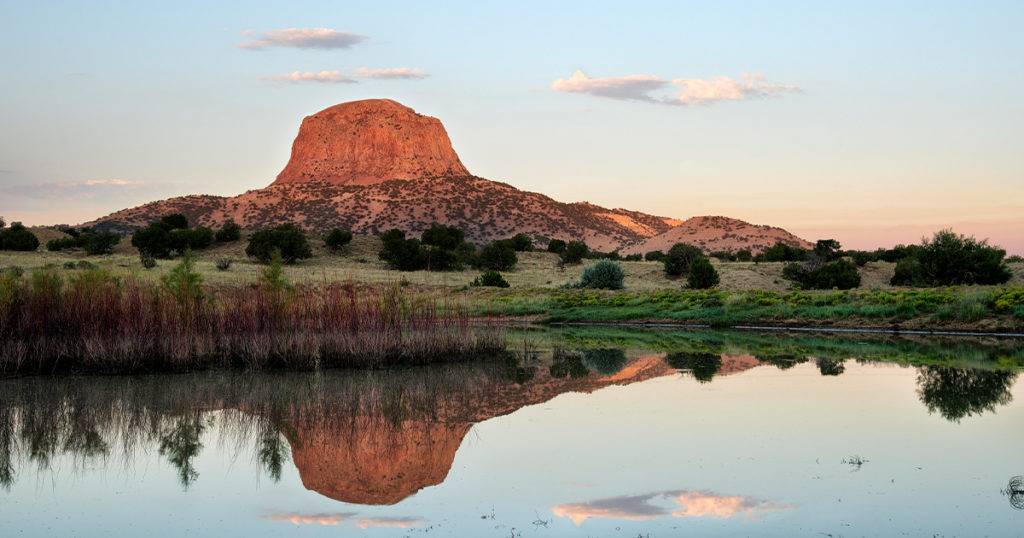
Earth Keeper: Reflections on the American Land by N. Scott Momaday; Harper, 80 pp., $17.99
Scott Momaday was the first big voice of the American Indian literary renaissance that began a half century ago. He describes himself as “Pan Indian,” one who speaks across tribal lines and embraces all his Native ancestors. At the same time, he has become an American icon. His life story is straight out of national folklore—a rags-to-riches tale that began in 1934 on an impoverished cotton farm in Dust Bowl Oklahoma and has brought him to the heights of literary acclaim and an art-filled home in the Tucson foothills.
Momaday’s parents were reservation teachers, his father a Kiowa artist and his mother a white migrant from rural Tennessee. They raised their son on the Jemez Pueblo in New Mexico, and after attending a Virginia military academy, he graduated from the University of New Mexico and earned a PhD in English literature at Stanford University. His first book concerned an obscure 19th-century New England poet. He then turned to teaching Indian stories and mythology. That move led to his first novel, House Made of Dawn, published in 1969, which won a Pulitzer Prize. Thus, adept in both white and Indian communities, Momaday found his calling as a cultural hybridizer—and what is more American than that?
His latest offering is a slender book filled with loosely connected sketches and vignettes interspersed with watercolor images he has drawn from folklore. Earth Keeper is a celebration of the rich spiritual imagination of America’s Native peoples—of their worldview rooted in specific geographies and in the hunting life, of a consciousness focused on sun and stars, insects and birds, and not least on humans, whose role is to “keep” the planet whole and healthy. These were also the themes of his 1968 classic, The Way to Rainy Mountain, which tracked the author’s search to recover an identity rooted in a distinctly Indian cosmos.
Momaday is on a mission to save the whole of America by instilling that perspective in order to protect nature and the natural order. It is not Indians, he believes, who are turning order to disorder; it is other Americans who have fallen into ignorance, indifference, and confusion. Now, he argues, it is time for the others to accept guidance from Indians on how to live securely by loving and cherishing the land. “The earth and its inhabitants are in crisis,” he warns, “and at the center is a moral crisis.” America is failing to teach and practice an ethical relation to nature grounded in awareness of its intrinsic beauty and order.
Momaday, now 86 years old, must be ranked among the greatest of our contemporary writers and our environmental prophets. A distinguished chain of Euromericans have come before him—Henry Thoreau, John Muir, Aldo Leopold, Rachel Carson. But no one from the Indian community has ever added so much as Momaday to that chain of cultural critique. No one has been more important than he in bringing Indians forward as keepers of our national conscience.
A skeptic might ask whether such a message requires us to go back to an ancient Indian hunting-and-gathering way of life. Or does it mean rejecting science, putting traditional arts and philosophy in its place? Momaday does not address such questions here, but neither does he argue that we must try to feed ourselves by going back to that lost way of life. There are too many of us to allow such fantasy. Although he is a shaman, a poet, and a painter, perhaps he would acknowledge that many scientists share his feeling for the magical beauty of a world we have not made. He writes out of hope, not nostalgia or divisiveness, insisting that all humans have far more creative potential than we have used, and that we can transcend our current material conditions and create a different way of thinking and living. We can revive old values and ethics, making them live again, and we can imagine new values and economies. But his kind of hope requires getting out of our shells and encountering the earth directly and humbly as the ancients did. “If you stand still long enough to observe the things around you,” he promises, “you will find beauty, and you will know wonder.” And then the human imagination can work the most profound kind of change.
Hope is in scarce supply these days. We hear many panaceas, mostly political and economic cures arrayed along entrenched battle lines. Momaday transcends the familiar cultural wars, and that is why he offers a more profound hope. Indigenous values can conceivably become a bigger part of American values. If that happens, he reassures the reader, we can overcome humankind’s age of crisis, for we will have learned to “remember the earth.”

